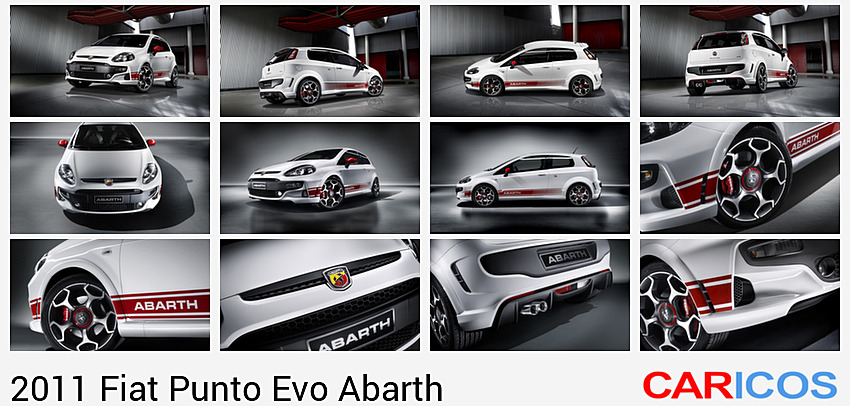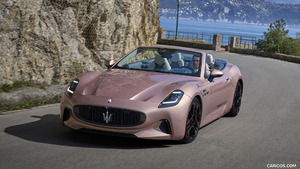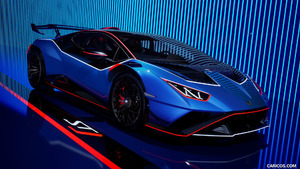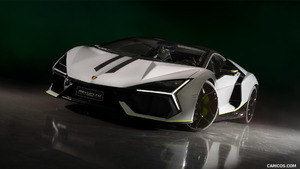2011 Fiat Punto Evo Abarth
Technological EVOlution inspired by racing
The new 165 HP MultiAir 1.4 Turbo petrol engine is the result of the successful union of Powertrain technology (FPT) and the work of Abarth engineers. Since its presentation last year at the Geneva Motor Show, the Abarth engineers began to work on this new technology with the aim of improving its sporting performance and turning it into a true Abarth.
MultiAir technology marked a departure from the normal petrol engine scenario. Compared with a conventional petrol engine of equivalent size, a MultiAir engine develops more power (up to 10%) and torque (up to 15%), while consuming significantly less fuel (up to 10%) and emitting less CO2 (up to 10%).
At the heart of MultiAir is a new electrohydraulic valve management system that allows a reduction in fuel consumption and polluting emissions by controlling air directly via the engine intake valves, without using the throttle. From this starting point, Abarth engineers performed studies and numerous technical tests before they finally produced the innovative 165 HP MultiAir 1400 16v. Tuning was carried out with great care by the engineers, who used a new oversized Garrett turbine to guarantee winning and sporting performance: maximum torque of 250 Nm (25.5 kgm) at 2250 rpm for acceleration from 0-100km/h in just 7.9 seconds.
Like a true sports car, the Abarth Punto Evo is fitted with a driver controlled system that acts on the engine, brakes and steering, allowing two different vehicle behaviour modes based on the driving style best suited to the situation or the customer’s wishes: super sports (Sport) and urban (Normal).
The selector is located in an ergonomic position – in front of the gear lever on the tunnel – and allows the driver to select one of two operating modes, simply by moving the lever (the selection is displayed with a message on the control panel). In detail, if you wish to achieve a relaxed drive in complete safety, you can select Normal mode; but if you prefer to use your Abarth Punto Evo for a more sporty drive, you simply move the lever to Sport position. This makes the car even more responsive and the setting of the electric power steering is altered to increase load for a sportier feel. Greater focus is also placed on safety, with automatic activation of the TTC system.
The driver is assisted, rally style, by a Gear Shift Indicator (GSI). This intuitive ‘co-pilot’ on the Abarth Punto Evo offers the driver suggestions about the right moment to shift up to keep fuel consumption down by means of a message on the control panel.
The Abarth Punto Evo MultiAir 1.4 petrol engine is enhanced by the innovative Start&Stop system. The device controls temporary engine cut-off and subsequent restarting when the engine is idling at a standstill. In these situations, which are typical of heavy traffic in urban areas and when stopped at traffic lights, , the system automatically cuts out the engine when the control strategy permits in order to reduce fuel consumption and emissions by up to 10% in urban conditions and 3.5% over an NEDC type-approval cycle.
As soon as the brake pedal is released or a gear engaged, the system quickly restarts the engine to ensure the user an immediate response to controls. If the engine is switched off by mistake (a stall), when setting off from a traffic light, it can be restarted by simply pressing the clutch.
The Start&Stop system offers further advantages in terms of passenger compartment comfort because there is no vibration or noise.
The system interacts with the driver, who is informed about the use of the device by means of messages on the control panel and can always turn it off using a control on the panel near the steering wheel.
The innovative MultiAir power unit guarantees sporting performance with low emissions and low fuel consumption. During tests carried out by Abarth engineers, fuel economy was improved despite the high sporting performance of the engine. More specifically, fuel consumption is 8.1 l/100km over an urban cycle, 6.0 l/100km over a combined cycle and 4.8 l/100km over an extra-urban cycle. Emissions from the MultiAir engine are low, ensuring Euro 5 type-approval with emissions of just 142 g/km.
EVOlution of active and passive safety
The Abarth philosophy is to guarantee sporting performance in complete safety. For this reason, the Abarth Punto Evo is enhanced by devices that ensure the best dynamic performance over any surface.
The icing on the cake is TTC, Torque Transfer Control. This device improves the transfer of drive torque to the wheels and, in particular, guarantees excellent cornering behaviour, thus making the car safer and more entertaining during a sporty drive. More specifically, the TTC is a differential lock system that uses the mechanical differential as a reactive element, distributing torque through the braking system by means of the ESP sensors (wheel speed, steering wheel angle, yaw etc.).
The TTC is activated automatically in sport mode and self-regulates the lock percentage according to dynamic characteristics such as speed.
In the area of safety, the Punto Evo Abarth sets new standards due to its 7 airbags, including a driver knee bag. It is one of very few cars in its segment with a driver knee bag fitted as standard on all versions. The Punto Evo Abarth braking system is powerful and effective. Disc brakes are fitted on all wheels. The front brakes are ventilated with fixed Brembo twin piston calipers. The suspension system is based on a tried and tested Abarth configuration: the front is a MacPherson independent suspension and the rear is an interconnected suspension (semi-independent) with torsion beam. Compared with normal braking systems reworked by Abarth, the anti-roll bar is oversized and the front springs are 20% stiffer. These improvements guarantee impeccable roadholding while maintaining a high level of comfort.
Race-inspired aerodynamic EVOlution
As far as looks are concerned, Abarth's work on the Punto Evo aimed to improve performance with attention to aerodynamic aspects.
Compared with the Fiat version, the front bumper has been broadened so that it runs seamlessly into the side strips and the front valence has been moulded at the base to make room for side intakes, which guide and correct the airflow to significantly improve aerodynamic flow at the side, drawing inspiration from the rally version. The completely revised rear bumper incorporates side vents and a distinctive new diffuser that optimally channels the airflow. Compared with the previous version, the diffuser is now unframed to give it greater emphasis and its look reflects that of the front splitter.
The twin exhaust tailpipes are larger in diameter, a clear tribute to Abarth's history, and also feature different satin finishes.
The reverse and rear fog light functions have been moved to the centre of the diffuser to focus the attention, as on Formula 1 cars. New side reflectors frame and accentuate the aerodynamic profile almost as if to mirror the effect of the LED lights on the rear window.
The spoiler has been fully revised in terms of its colour (now it is the same shade as the body to make the car's lines more continuous and dynamic) and above all in its volume: the new long, tapered shape improves cx and CZ performance values, making the Abarth Punto EVO even more stable.
The 'moustache' motif around the logo has been completely revised and made sportier due to the look of the grille. In the same way, the badge bearing the icon is no longer round as on the previous car but has reverted to the historical shape already incorporated in the Abarth 500.
The side strips and side skirts are body-coloured to emphasise the stance of a car that is truly glued to the ground. The side graphic motif is now part of the front bumper and has been resized to stabilise the proportions of the side panel thus making the body coloured surfaces more slender. Another new feature is a fully redesigned 17’’ wheel trim with spokes inspired by the Abarth symbol, the Scorpion, which is also evident on the hub caps. The interior has also been fully redesigned. The appearance and finish of the materials used are reminiscent of the road surface on racetracks, thus taking the feel of the track inside the passenger compartment.
The new central control console has been split into two, with the radio module featuring a glossy black surface, at the centre of which lies the LCD. The climate control system controls are positioned below, in a separate panel, while the air vents with a storage compartment are located above.
The driving instruments produced specially by Jaeger feature larger speedometer and rev counter faces, a new sporty graphic layout and new hood to protect against the sun trimmed in leather with red and yellow top stitching.
Work on the seats, with their new texture, is evident. Soft black leather is used to trim the seat and backrest while the containment bands are trimmed in hi-tech fabric to offer the right balance between comfort, breathability and resistance to wear.
Just as before, it is still possible to fit Abarth Corse monocoque seats by Sabelt, which offer the best possible combination of sports seat characteristics, such as lightness and the ability to restrain the body in the presence of lateral and longitudinal forces.
TECHNICAL DATA SHEET of the ABARTH PUNTO EVO 1.4 Turbo MultiAir 165 HP E5 3P Start & Stop
Engine
- 4 cylinders in line, 4 valves per cylinder, 1368 cc
- 165 HP (120 kW) at 5500 rpm
- maximum torque of 250 Nm ( 25.5 kgm) at 2250 rpm
- turbocharged with fixed geometry Garrett GT1446 turbocharger
- digital electronic solid-state ignition
- Start&Stop system
- digital Gear Shift Indicator
- new electrohydraulic MultiAir intake valve management system
Transmission
- 6 speed manual gearbox
- lever for activating sporty drive (n/s)
Suspension
- front suspension with MacPherson layout and oversized anti-roll bar
- rear suspension with semi-independent configuration and torsion beam
Steering
- electrohydraulic power steering
Brakes
- Brembo M4x40 front brake calipers
- front brakes with Ø 305mm x 28mm self-ventilated discs
- rear brakes with Ø 264mm x 11mm discs
- with ABS + ESP
- torque transfer control system (TTC – TORQUE TRANSFER CONTROL)
Wheels
- 7” X 17” ET 39 alloys, 5 pincer-shaped spokes with internal paint coating
- 215/45 R17” tyres
Emissions level
- complies with Euro 5 EEC-p5 standard
Emissions of CO2
- 142 g/km
Fuel consumption
- combined cycle (l/100km) 6.0
- extra-urban cycle (l/100km) 4.8
- urban (l/100km) 8.1
Performance
- top speed: 213 km/h
- Acceleration: 0-100 km/(sec) 7.9












